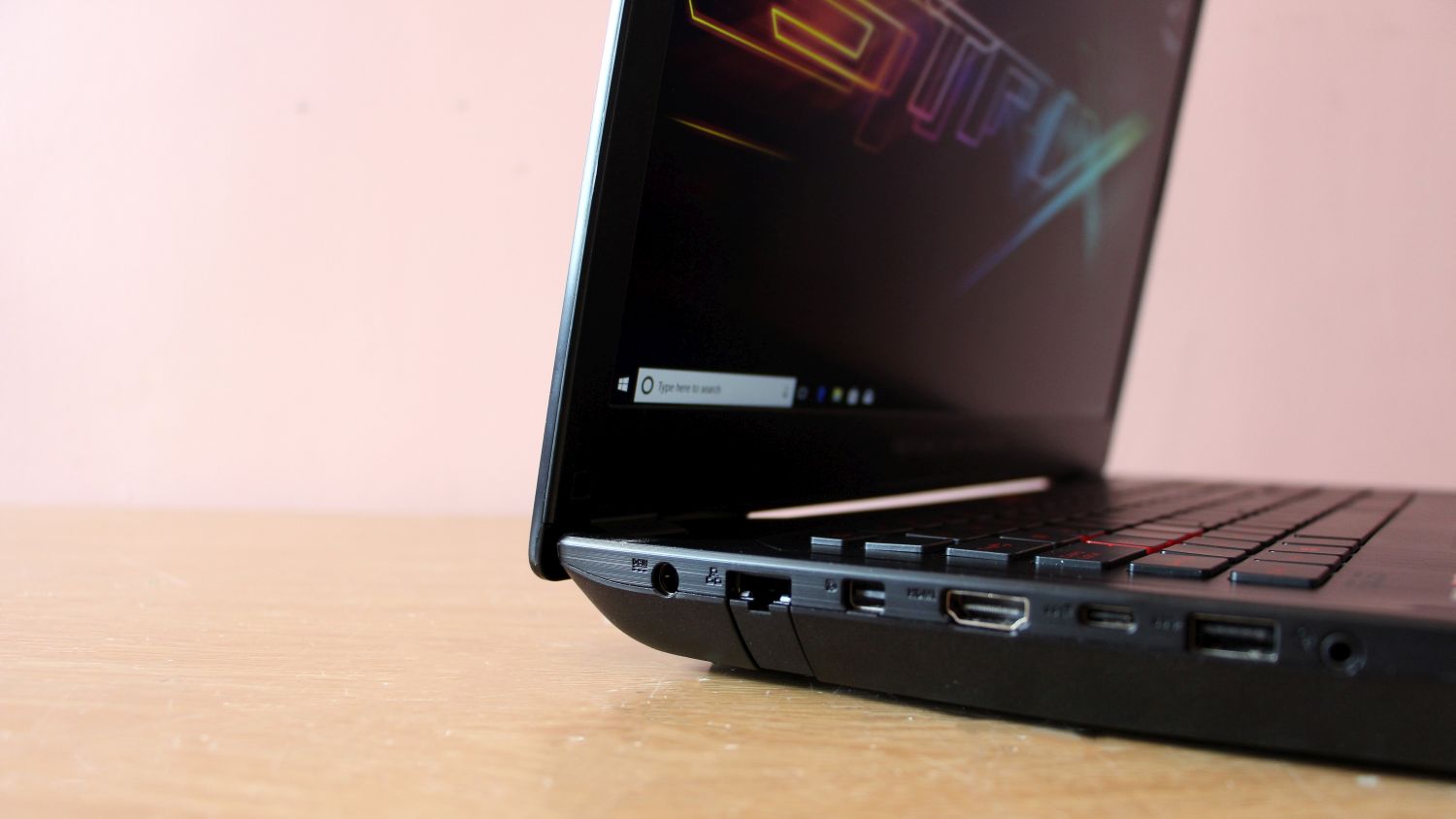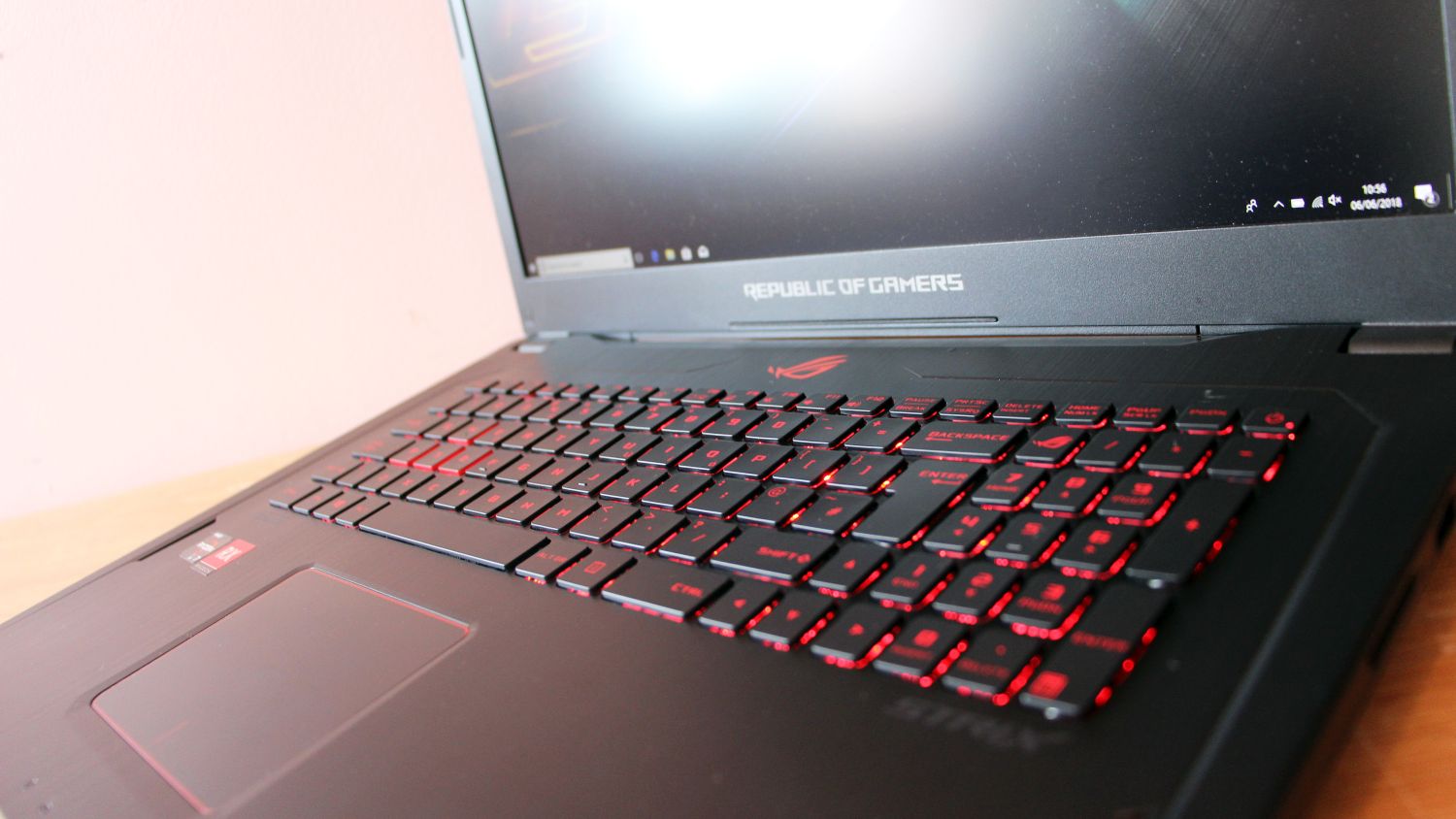Asus ROG Strix GL702ZC
The Asus ROG Strix GL702ZC is an unusual gaming laptop. On the outside, it looks like so many other gaming portables: big, brash and heavy-duty.
Delve inside, though, and you’ll find a laptop powered by some of AMD’s finest desktop hardware – and a price that’s surprisingly low depending on where you look.
The gulf between desktop and laptop hardware has never been smaller, though, so should you opt for a portable with proper PC parts – or is it better to stick with mobile silicon?

Price and availability
The GL702ZC launched at nearer to $1,840 (£1,400, AU$2,482), but it can now be found for between £1,000 and £1,100 in the UK.
In the US, the GL702ZC costs around $1,499 – a straight conversion from the UK price. In Australia, though, you’ll have to pay around $2,399. That’s more akin to the original launch price.
The Asus squares up to tempting rivals. The HP Omen 17 is a large, stylish notebook that has a 4K display and GTX 1070 graphics – but an old Intel processor. It’ll set you back around $1,772 (£1,350, AU$2,390).
There’s home-grown competition, too. The $1,838 (£1,400, AU$2,479) Asus ROG Strix GL502 has a 15.6in 1080p screen – and it also uses a GTX 1070.
Design
The Asus ROG Strix GL702ZC is filled with desktop technology, but it looks like a conventional gaming laptop. It’s got a chrome-effect logo on the lid, and it’s made from smart, dark brushed aluminium, and the dark metal and plastic is accented throughout by red highlights.
The Asus ROG Strix GL702ZC looks good, but it’s not light or slim. It tips the scales at nearly seven pounds, and it’s 1.33 inches thick – so it’s a little thicker than the HP Omen 17.
For all of the good looks and size, though, build quality is inconsistent. The base panel is strong, but the metal around the trackpad and keyboard is a little flimsy. The screen is a bit wobbly, too. It’s certainly sturdier than the plasticky HP Omen, but you’ll still want to slip the Asus into a protective sleeve on the road.

Connectivity is fine, with three USB ports, a USB 3.1-Type-C port, and HDMI and DisplayPort outputs. On the inside you’ve got the usual Gigabit Ethernet and dual-band 802.11ac wireless. You don’t get internal access, though – which is disappointing, especially if you want to upgrade or change components.

Asus provides 1.6mm of travel on the GL702ZC’s chiclet keys, which is a tiny bit more than most gaming laptops. The buttons, unsurprisingly, are good: they’re firm and fast, with a consistent action and a solid feel beneath the finger.
That means they’re excellent for typing – which is handy, as Asus reckons that the GL702ZC is an ideal creative workhorse. However, the chiclet keys are still only mediocre for gaming, as they don’t have the travel or clinical feel of a proper gaming keyboard.
Meanwhile, the trackpad is good. It’s smooth and responsive, and its two built-in buttons are shallow and fast – so they do a decent job of mimicking a gaming mouse.
Installing a desktop CPU in a laptop is an unusual move, and Asus has relied on first-generation Ryzen for this machine – but cramming AMD silicon inside the GL702ZC makes plenty of sense.
The eight cores can address sixteen concurrent tasks, which means that the Asus has enough multi-tasking ability to handle content creation, video work and creative applications.
The chip runs at a solid 3GHz that reaches 3.7GHz with Turbo, and it’s paired with 16GB of memory, a 256GB SSD and a 2TB hard disk.
The octo-core CPU delivered Geekbench single- and multi-threaded results of 3,340 and 15,578. They’re great results: the former is on par with anything Intel can offer in consumer laptops at this price, while the latter is around 3,000 points beyond Intel’s current six- and quad-core laptop processors. The GL702ZC’s Cinebench score of 1,307cb was twice as good as its rivals from HP and Asus, too.

Those excellent results mean the Asus will handle photo-editing tools, video-editing software and content creation applications with more pace than any rival. Unsurprisingly, web browsing, office applications and games won’t prove problematic either.
Graphical grunt comes from an AMD Radeon RX 580 – another bit of desktop silicon. The GPU has 2,304 stream processors and 4GB of memory, but its 1,257MHz core has been clocked down to 1,077MHz in order to help improve this laptop’s thermal prospects.
It may not have the specification to match the GTX 1070 GPUs included in its rivals, but it’s still a potent part. It zipped through our test games at Ultra settings at more than 40fps, and it scored an impressive 25,219 in the 3D Mark Sky Diver test – only a few hundred points behind the HP Omen and Asus machines.
The GTX 1070 will be a little quicker in games, and its extra memory will give it more headroom for future titles.
Don’t fret, though: any current game will run smoothly on the AMD-powered Asus, and it easily has enough power for graphical work. It’ll also output to larger screens without issue.
The one disappointing result came in the storage test, where the SSD delivered read and write speeds of 441MB/s and 405MB/s. They’re poor, even for a SATA drive. You’ll notice the difference in loading times. And, annoyingly, the Asus uses single-channel memory – another odd inclusion that will impact performance.
The powerful, desktop-level internals work well for gaming and content creation, but they do hinder the Asus in thermal tests. The processor and graphics card peaked at 70°C and 80°C during a gaming test, which is fine, but the CPU topped out at 94°C in a full-system test. That’s too high, and a worry if you want to use this laptop for work. The Asus was consistently louder than its rivals, too.
Battery life isn’t anything to shout about, either. The Asus could only deliver around an hour of longevity in gaming and tough work tests, so you won’t get much more than that even with careful power management. You certainly won’t’ get a full day away from the mains.
Screen and Speakers
The Asus’ 17.3in screen is a 1080p IPS panel with 60Hz AMD FreeSync. So, if you run games at 60fps or below, the GPU and screen refresh rates will be synchronised for butter-smooth gaming.
That’s great, but the HP has a 4K panel, and both rivals also have syncing technology.
The GL702ZC delivered inconsistent quality, too. Its 391cd/m2 brightness level and 0.34cd/m2 black measurement are both good, and the contrast ratio of 1,150:1 is solid – high enough to provide impressive depth in games and films.
The average Delta E of 8.4 is disappointing, though, and the color temperature of 7,688K is too cool. The panel also only rendered 83.7% of the sRGB colour gamut.
Those latter results saw games and films look a little pallid, and they also mean that the Asus’ panel doesn’t have the colour accuracy required for many creative tasks. If pixel-perfect colours are key for you, the GL702ZC won’t be good enough.
The speakers, meanwhile, have loads of volume and bass, and good punch elsewhere. The treble range is a little muddy, but the audio kit is good enough for gaming and entertainment.
Verdict
The Asus offers loads of power, especially in the processor department, and it serves up a desktop-level GPU inside an attractive and ergonomically-pleasing enclosure.
In other departments it’s far more ordinary, though – which leaves this laptop feeling a little unbalanced, even if the price is tempting.
AMD’s desktop processor and graphics card deliver great performance, especially in multi-threaded applications – but the GL702ZC’s sheer grunt comes at a price. This laptop is louder and larger than most of its competition, and it brings disappointing battery life along for the ride.
However, it is also ergonomically solid and has plenty of power, but unless you need eight cores then you’d be better off with a more balanced machine that relies on traditional notebook components.
- Check out our pick of the best laptops of 2018
0 comments:
Post a Comment